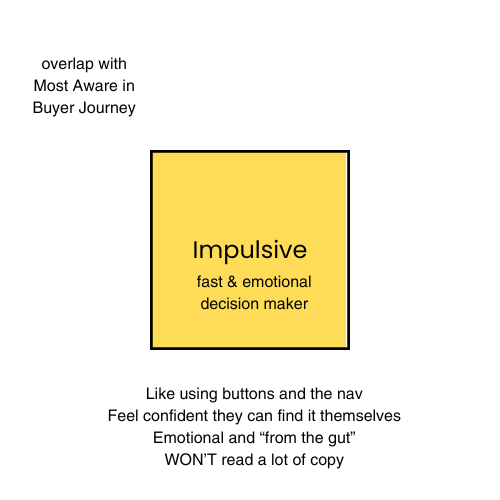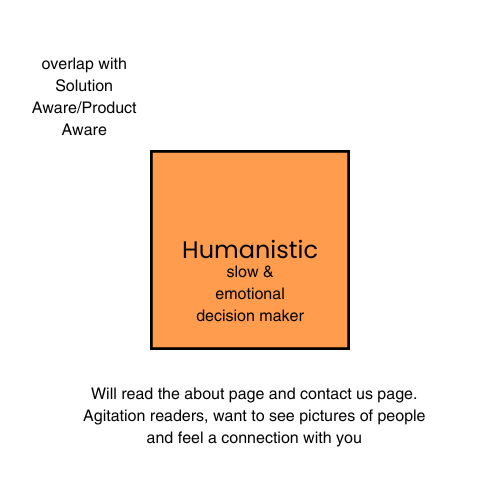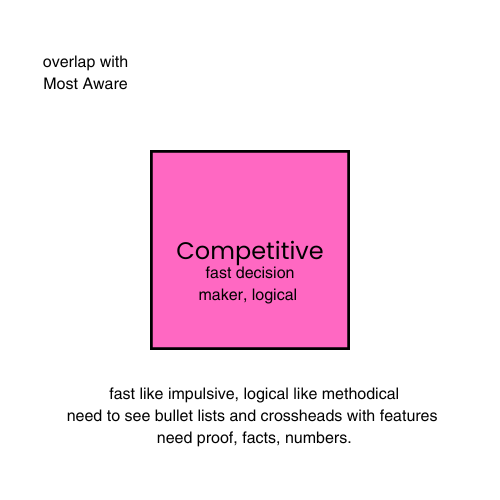There are 4 other types of decision-makers who are likely to visit your homepage and read the copywriting (aka the words that are selling all the things).

Impulsive
Humanistic
Methodical/Skeptical
Competitive
If you want to have a homepage that converts, you have to start looking at how people make their buying decision. And they are not all impulsive.
Cinderella isn’t the only Princess at Disneyland
If we were to rank Disney Princesses by popularity, Cinderella wins by a landslide. She’s got the glamour, the prestige, the pet mice/pumpkin carriage…plus a ton of sparkle.
While she is the most popular princess in the Disney monarchy she only holds that title with 13% of the vote.
If you staffed Disneyland with nothing but Cinderella impersonators because she is the most popular princess, your job would be bippity-boppity GONE. Disappointing 87% of Disney Princess-loving park attendees doesn’t make any sense, does it?
How about disappointing 87% of your website visitors?
Not everyone’s favourite princess is Cinderella.
Not everyone takes in information and makes decisions in the same way.
This is what makes Homepages hard to write.
This is what makes homepages that convert difficult to find in the wild.
Most homepages ignore this difference completely, toss everything onto the homepage and hope that someone clicks on it so that they buy something.
Most homepages are written for one type of decision-maker, the Impulsive decision-maker.
This is true despite the fact that they aren’t going to read your whole home page anyway…cause they are going to click something and fast.
Disney doesn’t stock their park with Cinderella only.
Your homepage shouldn’t serve only an Impulsive decision-makers.
If you want to reach every type of decision-maker, you’re going to have to serve them all on your homepage.
People Only Read Copywriting that Matters to Them
You think that people don’t read. They do…just not things that aren’t important to them.
Some people only read fiction.
Others are die-hard non-fiction addicts.
Some only read cookbooks and others like to read about economics.
This is why bookstores are broken up into several sections so that people can easily find what they are looking for…and book sales are booming. People read. We know they do.
For a business trying to convince people to buy or at least stick around and hear your offer, you have to make it intuitive and easy for every type of decision-maker to find what they are looking for.
You have to serve them all. Easy, right?
Here is how you make your homepage feel intuitive to every type of decision-maker.
Impulse Driven Decision Maker – Short Copy Hero
The Impulsive decision-maker isn’t going to read your whole home page.
So why have you designed the whole page for them?
Your Impulsive decision-makers go with their gut in the top 10% of your homepage.

Tool dominant
Confident and independent
Emotional/From the gut
Doesn’t read
Who HERO sections were made to convert
Your Headline has got to be what is already going on in their minds.
The description of your offer has to be something they are intrigued by.
There needs to be a button that gives them permission to say yes to your offer.
A sprinkle of reassurance in the form of logos or testimonials doesn’t hurt.
They might peek at the next 20% of the page, which should feed their emotional need for proof they are not wrong to trust you.
Humanistic Decision-Makers Need Copywriting that Makes them FEEL something
The next 20% of the page is for Humanistic decision-makers.
They tend to need to feel something (this is where agitation comes into play.)

Slow decision-maker
Reads your about page
Hungers for human faces
Wants emotional connection
They are also the first to read your About page. Not only should the words make them feel, but give them a human face to empathize with, not another icon.
It doesn’t matter if you are selling dog food or financial services, this is the section that doesn’t need a picture of your fleet of vehicles or your office. It needs human faces that are relatable, someone like them.
These human-feeling decision-makers might also need to dip their toe into how you help them solve their problem with your solution. That is why this section is sandwiched between the Impulsive (go with the gut!) and the Methodical decision-maker.
Long Copywriting Myth Buster, the Methodical Decision Maker
Call it methodical.
Call it skeptical.
Call it what you like…but a HUGE part of your homepage is for the Methodical decision-maker. 40% huge. Because they will read EVERYTHING before they make a decision.
If there is nothing on your homepage to satisfy their curiosity (ahem, skepticism) about HOW you are going to be the answer to their prayers, they are not going to bother to go looking for it.
They are going to bounce.
Stop the bounce. Feed their curiosity without making them work for it.
This section should cover how and why they should trust your solution. Do you have some kind of special experience? Is there a special technology you are using? Why is it different from other solutions they might already know about on the market?

Slow decision-maker
Looking for logic to justify purchase
Needs lines drawn between their problem, your solution
Will read everything
Bring elements of your solution together with the known and documented problems of your ideal client.
Feed the logical side of their desire to KNOW you are the only right choice.
And don’t worry…if they are Impulsive they won’t read it. They’ll have already clicked a button away from your homepage and into exactly what they are looking for.
And Competitive decision-makers? They’ll need something to read on their second pass through the website.
Competitive People Need Copywriting that Tells them What’s in it for ME!
Competitive decision-makers lightly skim everything.
Then, they’ll will read the bottom of the page.
Weirdly, they then scroll back through the page, looking for logic, justification, and proof that the risk they take in saying ‘yes’ is low.
If you don’t have your logic in place…they bounce.
They are fast, but they are also logical.
That is why “the Close” goes here, at the bottom of the page.

Fast reader, will read if it applies to them
Logic needs to justify purchase
Has FOMO but also a fear of being scammed
Proof is a selling point
Not the news.
Not the blog section.
And not a bloody carousel. (we can talk about this another day)
This is where the bullet points and checklists of benefits come into play.
If you don’t have loads of benefits and features, create a tower of testimonials. Make it impressive by keeping them out of a carousel and easy to scroll through.
Strategically placing “The Close” at the bottom of the homepage serves 3 of the 4 decision makers we are trying to please.
1) Competitives get their fix of What’s In It For Me
2) Humanistics can justify their emotional response with a list/stack of justification.
3) Methodicals are able to compare their logic with benefits to come to a what feels like a weighed decision.
If you put “The Close” at the top of the page, people feel like they are being sold to. You haven’t satisfied their NEED. And it feels ‘Ick.’
Homepage Copy that Converts puts Modalities (and your prospects) First
Did you notice that this layout suggestion seems an awful lot like an old-timey sales process? That’s because it is.
Your homepage isn’t a business card or a showroom…it should be a salesperson who takes a client through the buying process. Empathizing, demonstrating, and closing. For every decision-maker who lands on your homepage.

Emotional – Impulsive and Humanistic
Slow – Humanistic and Methodical
Logical – Methodical and Competitive
Fast – Competitive and Impulsive
All four must be served!
Until you know with absolute certainty backed up with
testing
proof
interviews
and hot mapping
that your ideal client doesn’t read long copy, you don’t know what your prospect will or won’t read.
Once you have that data, you should start adjusting your homepage to be more weighted towards one than the other. But until you have proof, this is a good place to start.
Give them what they need to make the next decision. Or they will bounce to somewhere else.
Wanna learn more about the science behind all this decision making rah rah? Check out work by Psychologist Dr. David Keirsey. You can also find out more by reading Waiting for Your Cat to Bark, by Bryan and Jeffrey Eisenberg.
None of this science is new.
Need help documenting, understanding, and harnessing the power of what your prospect needs to hear/read before they say ‘yes’ to your offer? Let’s talk about conversion copy for your business.

View comments
+ Leave a comment